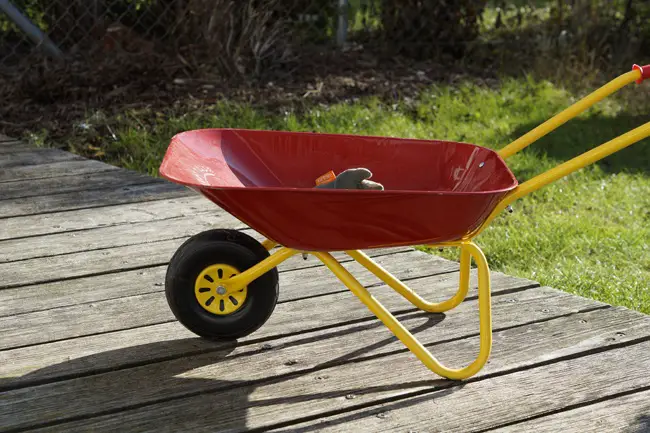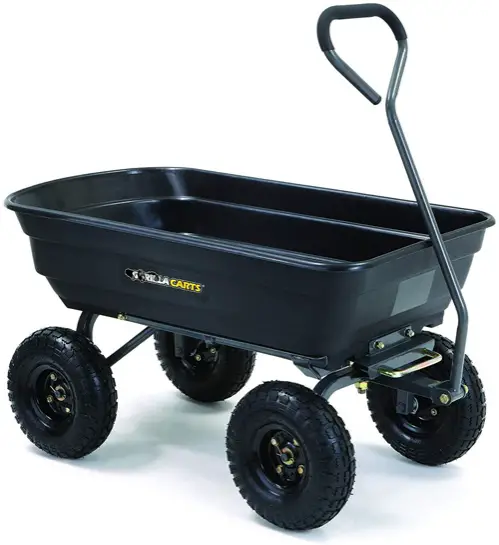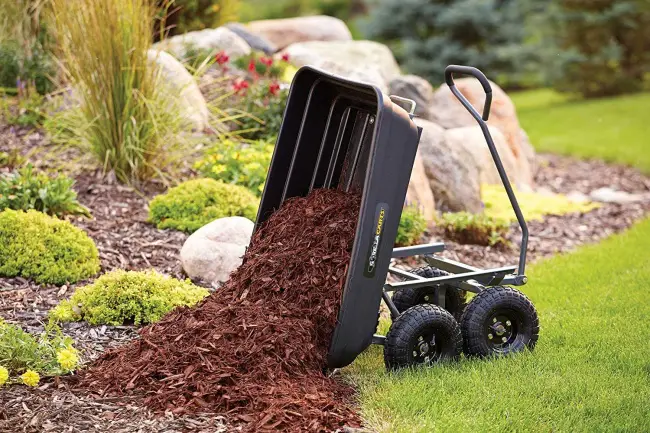Do you know the difference between a garden cart and a wheelbarrow? Since they both have pretty much the same function, what’s the difference? These two tools can be used to make gardening easier. Whether you’re a novice or an experienced gardener, having the right tool for the job is essential for success. But which one do you choose?
Let me start by saying this: both garden carts and wheelbarrows are designed with convenience in mind. Gardeners who want to transport heavy loads of soil should consider investing in either option, as they will reduce strain on their bodies while transporting materials around the yard. However, there are some key differences between them that need to be noted before making a decision.
Wheelbarrow
A wheelbarrow generally has one or two wheels on the front and sides that slope. They are perfect for transporting soil and gravel or other materials that will require dumping. Being able to walk behind it makes for easy maneuvering.
A wheelbarrow is a good option, especially if you are used to maneuvering it. But when I used a wheelbarrow, I found it a little inconvenient compared to a garden cart.
When I first started gardening, I used wheelbarrows for gardening transportation tasks. However, after I bought my first garden cart 3 years back, I feel it is more comfortable to use.
Another disadvantage of a wheelbarrow is that it’s a little wide. So if you have raised beds and narrow paths in your garden, a wheelbarrow is going to be much more difficult to maneuver compared to a garden cart.
Garden Carts
Garden carts have flat bottoms and need to be pulled by one or more persons. Garden carts are steadier than wheelbarrows and can usually handle larger tools. Smaller carts can easily carry tools and flats of plants plus other gardening supplies. Some carts come with sturdy covers, which make for excellent seating to prevent bending and stooping while gardening.
As of now, you can find many garden carts that are made of steel and sheet metal with a powder coating for rust protection. These carts are good for large gardens or large gardening projects like mulch, topsoil, fertilizers, plants, and moving heavy garden tools.
A garden cart is something that will make your gardening to become a lot more enjoyable. By using it, it will be very easy to carry your stuff around the garden.
The garden cart that I am using now is the Garden Dump Cart that Gorilla Carts manufacture. I was ordering the cart through Amazon. When I first received the cart and started unboxing it, it wasn’t really as heavy as I thought. It is actually pretty light and easy to carry. It has a plastic base, and this should be considered the lower-end version of the Garden Cart that I have.
There is a higher-end version that comes with a much more sturdy base. But I guess for most practical purposes, the plastic cart should be good enough. It’s got 4 nice wheels. Its got clear instructions on the assembly, and all the parts are pretty well packaged.
A garden cart has 4 wheels which makes it easy to maneuver the cart, and it also has a Dump feature which makes the emptying tasks very easy.
Design
Garden carts and wheelbarrows are very different beasts. The garden cart looks like a beast of burden, with its four large wheels rolling it along the ground as if to say “look at me!” Whereas, the wheelbarrow is much more subtle in its design – only two smaller wheels balancing their load ever so gracefully on one side.
The size of each tool also varies greatly. Garden carts are typically bigger than wheelbarrows and can carry heavier loads too. They’re made for bulkier items that need hauling around gardens or even over rough terrain such as construction sites. Wheelbarrows, on the other hand, are designed for lighter duties such as moving mulch or soil from one place to another.
No matter which you choose, both tools come equipped with handles that make them easier to transport; however, they differ in maneuverability due to their designs. Garden carts have wider axles and thus greater stability when turning corners while wheelbarrows require skillful navigation when making sharp turns.
Operation
After discussing how garden carts and wheelbarrows are constructed, we may move on to discussing their use. When it comes to getting things done in the garden or around the house, each has its own advantages. Most garden carts have a high capacity and a four-wheel design that makes it easy to move around the yard, even when loaded down with heavy objects like soil or boulders. Due to their low center of gravity, they are well suited for transferring heavy loads over unsteady ground.
The two-wheeled shape of a wheelbarrow makes it more manageable in confined situations and more suitable for transporting lesser loads. Also, unlike garden carts, you have more control over the amount of material you can transport with each lift.
Think about the bulk of your labor and whether you’ll be performing it on level terrain with consistent loads (in which case a wheelbarrow may be preferable) or on uneven ground (in which case a garden cart may provide superior results). Before proceeding with any method, double-check that the frame is strong enough to prevent injury to yourself or the machine.
Stability
Stability is a key factor when it comes to garden carts and wheelbarrows. Like two sides of the same coin, they both have unique qualities that make them stable in their own way.
Symbolically speaking, stability can be likened to a rock-solid foundation for any project or task at hand. It’s what gives us peace of mind and assurance that we won’t lose our balance during use. Here are five ways garden carts and wheelbarrows differ in terms of stability:
- Garden Carts: The wide base makes them more stable than wheelbarrows, even on uneven terrain.
- Wheelbarrow: Single wheels provide better maneuverability but less overall stability than garden carts with four wheels.
- Garden Carts: Can carry heavier loads due to their wider base and low center of gravity which increases their stability.
- Wheelbarrow: Its lightweight construction helps keep the load balanced over one wheel while providing great portability, but limited stability compared to a garden cart with four wheels.
- Garden Cart vs Wheelbarrow: Both provide good stability on flat surfaces like gravel or concrete driveways; however, if you need to move material up hills or across rough terrain, then a garden cart will offer more stability due to its wider base and lower center of gravity.
The difference between these two types of equipment boils down to how much weight you’re carrying, where you’ll be using them, and your personal preference – all factors which contribute to overall stability during use. With this knowledge in tow, let’s now move on to the next quality – maneuverability!
Maneuverability
Maneuverability is a key difference between garden carts and wheelbarrows. When it comes to maneuvering around tight spaces, wheelbarrows are much less agile than garden carts. Wheelbarrow handles are typically fixed in place, making them difficult to navigate through narrow pathways or doorways.
Garden carts on the other hand can be steered with ease thanks to their adjustable handlebars that rotate 360 degrees. This makes garden carts much more suitable for navigating through restricted areas like small yards or gardens.
Garden carts also provide users with better control over the terrain they’re traversing due to their four-wheel design which allows each wheel to move independently of one other. By contrast, most wheelbarrows feature two wheels that must remain directly behind one another at all times – meaning there’s no room for error when turning corners or negotiating curbs.
In terms of transportation capabilities, garden carts offer far greater versatility than wheelbarrows since they can be towed from either side instead of just pushed from the front end.
This means you don’t have to worry about straining your back trying to push a heavy load up an incline – simply hook the cart onto your tractor and get going! All in all, this makes garden carts vastly superior when it comes to maneuverability and transporting large amounts of weight.
Cost
Since wheelbarrows come in simpler designs with fewer parts, they tend to cost less than garden carts which require more materials and labor during production.
Space Requirements
Some people may think that garden carts and wheelbarrows are the same things, but nothing could be further from the truth. Garden carts have larger frames, and generally take up more space than a traditional wheelbarrow design.
That said, there is an array of sizes available when it comes to both types of vehicles; some garden carts can even be folded down for storage! With all this variety at your disposal, you’ll be able to find just what kind of vehicle fits your specific needs in terms of size requirements.
The material used also plays into how much room one will need for either type of cart or barrow. Plastic models tend to require less space due to their lighter-weight construction while metal-framed ones might call for slightly more room due to additional support components such as crossbars and axles being used. In any case, most modern designs are easily collapsible so they won’t take up too much space when not in use.
Maintenance
Maintaining garden carts and wheelbarrows is an important part of ensuring their quality, safety, and longevity. It’s not difficult to do either; just a few simple steps each year can keep them in top condition. To properly maintain your cart or barrow, start by cleaning it thoroughly with warm water and mild soap. This will help prevent rusting and other damage from occurring due to dirt buildup.
You need to check for any loose parts that may need tightening or replacing. If the wheels are wobbly, make sure they’re securely attached – this could be done yourself with a wrench or taken to a professional if necessary. Lastly, lubricate moving parts such as axles and bearings so they won’t seize up over time. Following these steps should mean you’ll have no trouble getting years of use out of your cart or barrow!
Garden Cart a Modern Version of Wheelbarrow
Now a garden cart is a modern version of the wheelbarrow. It’s much easier to maneuver, and the best part is its maneuverability. I have added a lot of weight to this garden cart. And it was actually easy to move it with all this weight.
I am guessing this would be about 75 lbs or so. You can easily navigate this cart between raised beds. But if you look at how easy it is to maneuver this cart along raised beds. If you have raised beds and have about 2 feet or so between them, a garden cart will work much better than a wheelbarrow.
There is a “Dump” feature of the cart, which you cannot do with a wheelbarrow. What you need to do is just lift the lock off, and you can dump whatever is in your cart.
If you’re mixing things like soil and fertilizer or anything in your garden cart, the dump feature lets you easily dump it without breaking your back.
This is our garden cart. It has many advantages like it lets you move a lot of soil and other things without breaking your back. It will also let you carry things that are heavy around your gardens, like fertilizer, plants, pots, and other things.
When you are moving something with a cart, you don’t need to lift it. At the same time, push it or pull it. Also, it is no need for you to use too much energy to keep the cart balanced since the 4 wheels that it has to make it stay very stable on the ground. Your job becomes very easy when you use a garden cart.
So, Which one should you choose?
For a beginner gardener with a small space, a small wheelbarrow or cart might be best for you once you have sized up your landscape plan. Remember, a bigger garden cart or wheelbarrow is not always the better choice if you can’t move it, so keep your physical limitations in mind before you purchase.
If lifting is a problem, get a wheelbarrow for the simple convenience of just dumping. Buy a cart or wheelbarrow of solid construction with smooth handles and a comfortable grip. Remember that metal will rust and that wood will warp (but it is durable), and carts or wheelbarrows made of heavy-duty plastic should be UV resistant.
Maneuverability can’t be beaten, especially when it comes to precise pouring, and it will prove invaluable for gardening tasks that require hauling and pouring. Whereas some people, a garden cart is a must for working around the yard and getting more work done in less time, and the versatility and convenience of pulling a load are hard to match.
Now which one suits you better is actually up to you to make your own decision. Those using a wheelbarrow for a while might like to use it or get a replacement wheelbarrow.
But for those looking to buy a new one, you now know what the difference is, and you can make a much more informed decision. Whichever you choose, the ultimate decision will be yours as to whether you choose a wheelbarrow or a garden cart.




